Mythbusters: Integrated versus Point solutions for Customer Engagement
Learn the advantages of an integrated solution for all Customer Engagement needs and explore MoEngage's best-of-breed partner ecosystem.
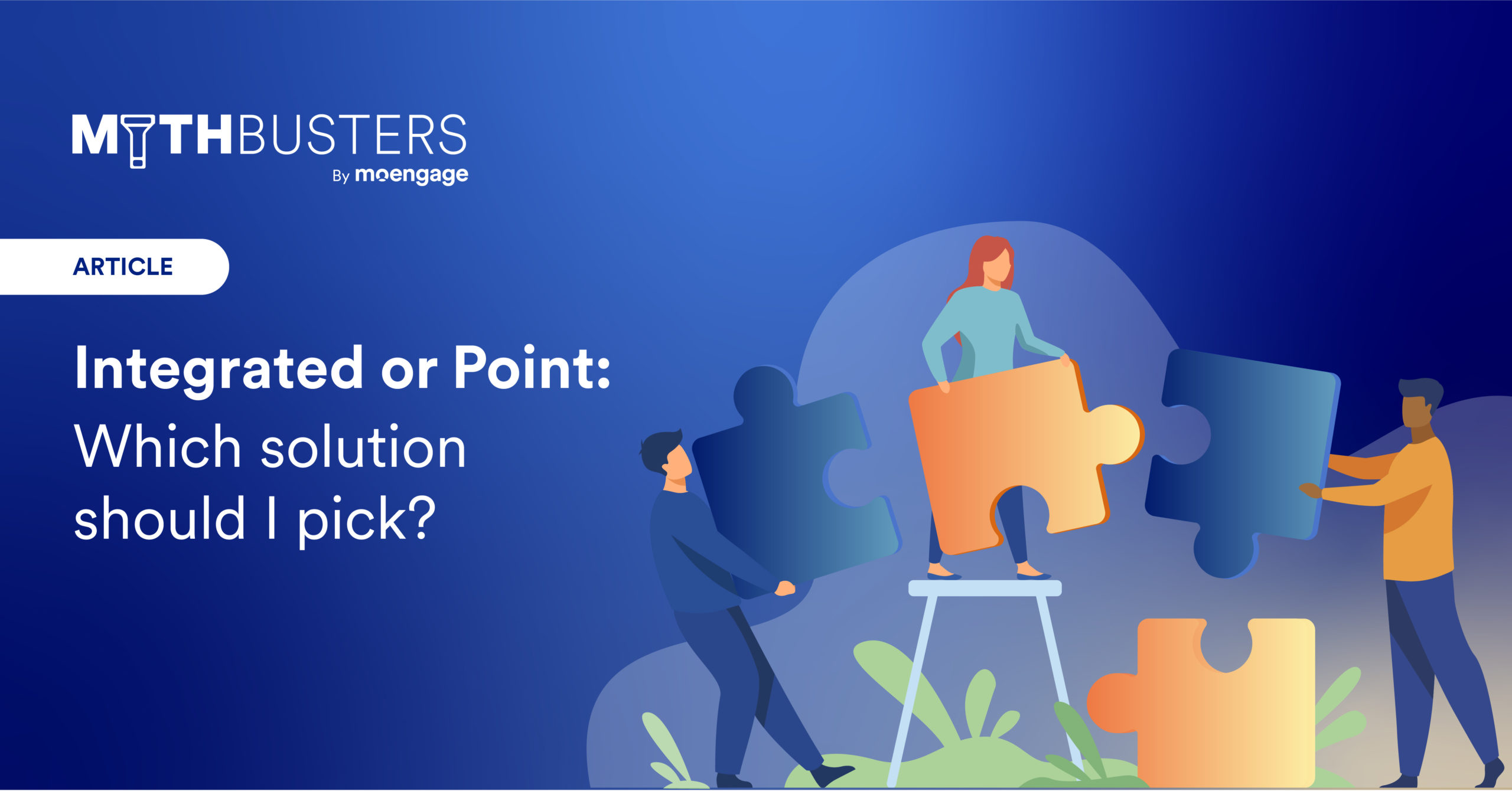
Reading Time: 11 minutes
| Mythbusters by MoEngage is a series that answers the most common questions and misconceptions in the world of Customer Engagement. With this series, we aim to help you guide your teams to the right practices and put your customers above everything else. This edition of the Mythbuster series concludes the endless debate of deploying a single Integrated or multiple Point solutions for Customer Engagement. |
Most consumer brands face a dilemma while building a tech stack that includes the right software solutions for Customer Engagement – deploy one single integration solution or go for a combination of multiple point solutions.
With an increasing focus on North Star business metrics and the need for seamless operational excellence, consumer brands cannot sacrifice one for the other. However, underestimating the effort needed to implement, gaps between expectations and reality, and tech complexity can lead to prioritizing one over the other.
But are brands really to blame? When problems arise, the first reaction is to adopt a point solution to solve that particular challenge. For example, if you realize the need to explore SMS as a communication channel because of its wide adoption, the first step you’ll take is to evaluate all available SMS delivery vendors.
While this approach is natural, setting up point solutions to solve specific Customer Engagement challenges can lead to complications when you scale.
Differences Between Integrated and Point Solutions for Customer Engagement
The fundamental difference between an integrated platform and a point solution to Customer Engagement is two-fold: flexibility and scalability.
Point solutions aim to resolve a single functional gap specific to a particular communication channel. On the other hand, an integrated platform solves multiple use cases and can be managed by different teams across business functions.
| One Integrated Platform | Multiple Point Solutions |
| Integrated, end-to-end business processes throughout all modules in the platform. | Multiple systems with several databases and various vendors to manage. |
| Simpler training and coordination owing to low implementation efforts, thus reducing cost. | Complex training and coordination with multiple parties, increasing both effort and cost. |
| A simplified approach to cross-channel reporting and analysis. | A complex ecosystem of individual technologies. |
| Single technology partner for all troubleshooting and maintenance issues. | Troubleshooting becomes difficult and time-consuming when problems arise across different solutions. |
| A 360-degree view of customers and promotions on a single platform across channels. | Absence of a 360-degree view of customers and their interactions across touchpoints. |
| Low maintenance cost as a result of a single technology stack. | An additional dependency on engineering teams to support and maintain multiple systems. |
| Enables smarter promotions, creating avenues for multiple teams with up-sell and cross-sell opportunities. | The solution is specific to one department or function only and does not have an impact on the entire organization as a whole. |
| Convenience and ability to innovate and adapt to changing market trends. | Need to constantly manage changing applications, interfaces, and data models. |
The Negative Impact of Point Solutions on Organization Structure
By implementing point solutions for your Customer Engagement needs, you end up creating silos. Your organization structure will look something like this:
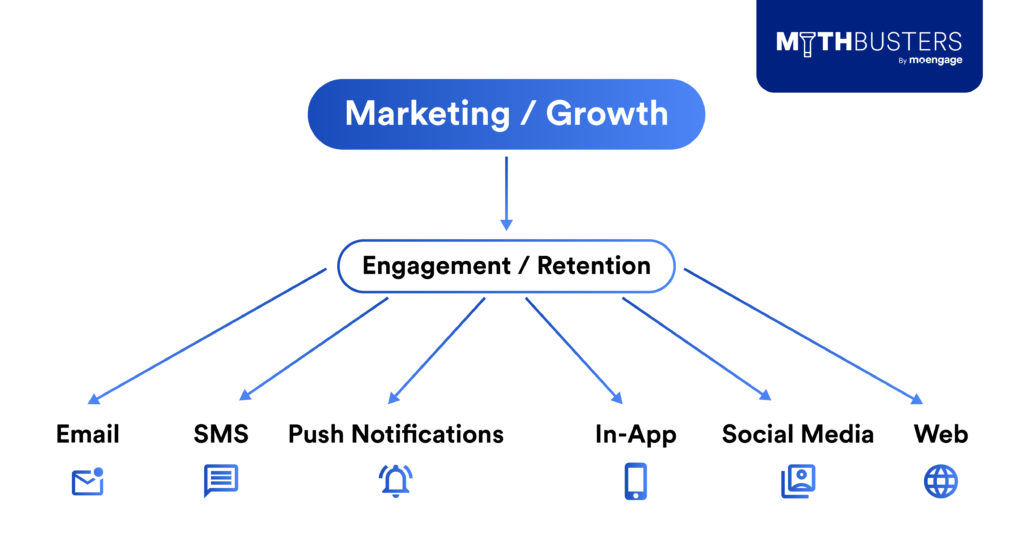
As the number of silos increases, access to customer profiles and channel-wide processes decreases.
This approach to Customer Engagement is “campaign-centric”, not “customer-centric“, leading to multiple individuals communicating with your customers instead of a single brand.
In today’s landscape, where consumers want a unified and connected experience across all touchpoints with a brand, this siloed approach is a recipe for disaster.
On the other hand, a single integrated platform enables seamless data sharing and optimizes organization-wide omnichannel efforts. This approach ensures your organization structure is aligned to the goal or the North Star metric you wish to achieve.
While selecting a single solution for all Customer Engagement challenges, an important indicator is the platform’s versatility, or how wide the partner ecosystem is.
Exploring MoEngage’s Best-of-Breed Partner Ecosystem
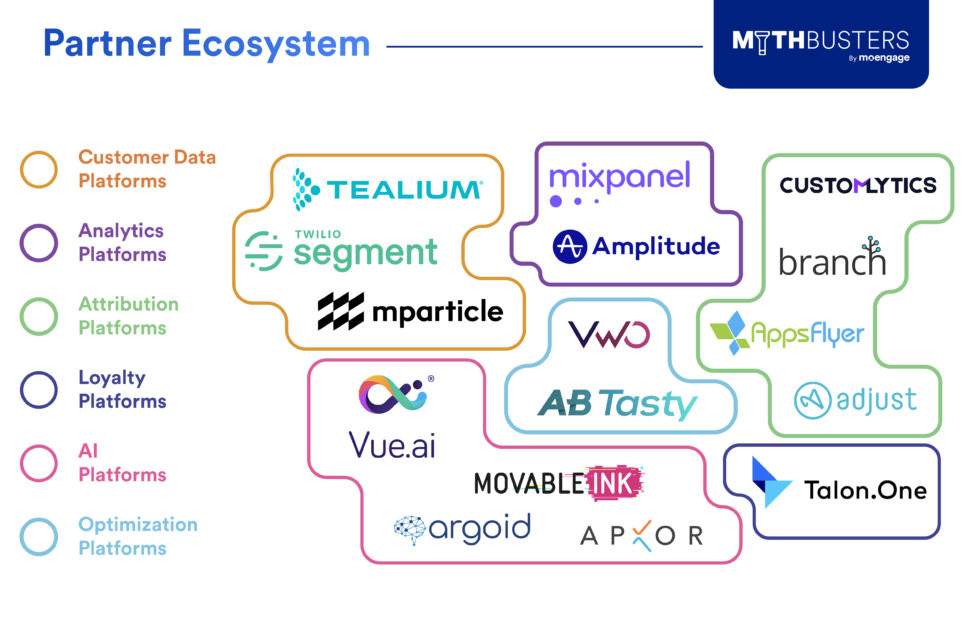
The MoEngage Partner Ecosystem is a trusted network of technology, consulting, and solution partners and resellers. This best-of-breed ecosystem thrives on empowering consumer brands like yours to up your Customer Engagement game.
Here’s a list of platforms that are an integral part of this ecosystem:
- Customer Data Platforms
- Analytics Platforms
- Attribution Platforms
- Optimization Platforms
- AI Platforms
- Loyalty Platforms
MoEngage + Customer Data Platforms
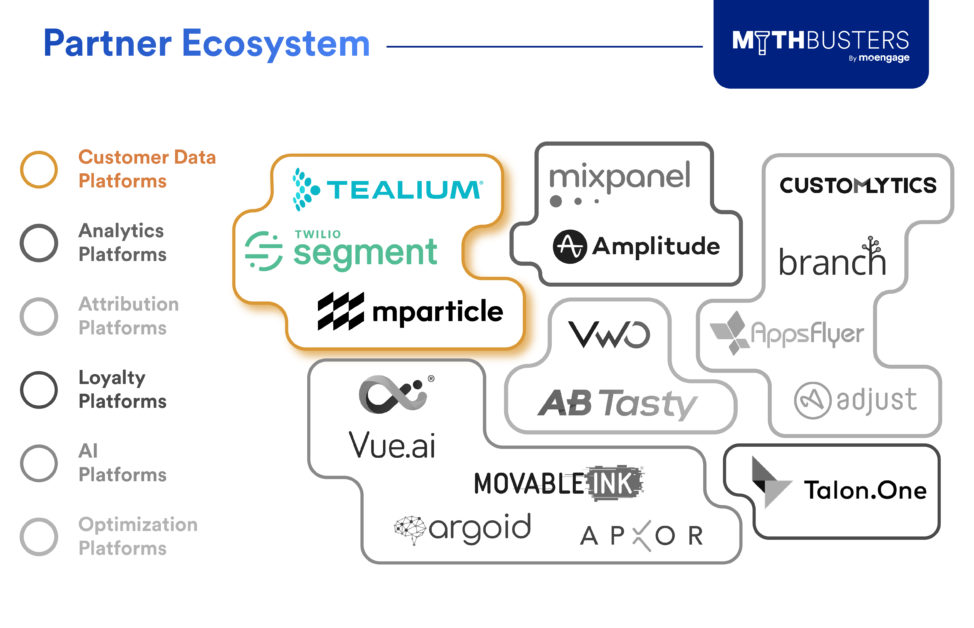
Achieving customer-centricity involves a two-pronged approach. The first step is gathering insights about your customers and their behavior. The second is leveraging these insights to create personalized experiences both on and off your platform.
Customer Data Platforms (CDPs) ensure that your data is consistent, centralized, and easily accessible. A Customer Engagement Platform (CEP) like MoEngage lets you create customer cohorts based on this data, and send relevant communication across multiple channels.
By integrating your existing CDP with MoEngage, you can:
- Reduce the time needed to go live by freeing up engineering time
- Enrich customer profiles with their behavior on your platform, interests, preferences, and affinity
- Predict which customer cohorts are about to hibernate, churn, or convert
- Segment customers based on multiple factors (like attributes, behavior, or preferences) to build hyper-personalized experiences that delight your customers
- Orchestrate cross-channel customer journeys to ensure efficient onboarding or increase LTV
- Increase the ROI of your campaigns by launching a promotion or retargeting campaign for the right audience, at the right time, with the right context
1. Tealium
With the help of real-time, enriched data received from Tealium, consumer brands can use MoEngage to execute contextually relevant campaigns and gather campaign interactions. These campaign insights can then be fed back into Tealium.
The Tealium <> MoEngage integration allows you to send event data from Tealium to MoEngage. This helps better engage customers and drive conversions through personalized interactions across channels like Push Notifications (across app and web), Emails, and In-app Interstitials.
2. Segment
Through the Segment <> MoEngage integration, consumer brands can harness actionable customer data to create hyper-personalized micro-moments both on and off digital platforms. You can use data and insights to identify customer cohorts, create segments, and build automated customer journeys to enable real-time engagement across multiple communication channels.
3. mParticle
The mParticle <> MoEngage partnership enables consumer brands to build a bi-directional integration that simplifies personalization and enables omnichannel marketing. You can leverage customer data from mParticle to segment your customers by their behavior on your platform or by their preferences. Then, you can use MoEngage to create predictive segments, affinity scores, and churn risks on the aggregated data. This will help you reach and engage the right audience with the right message.
👉 Learn more about the mParticle <> MoEngage integration here.
MoEngage + Analytics Platforms
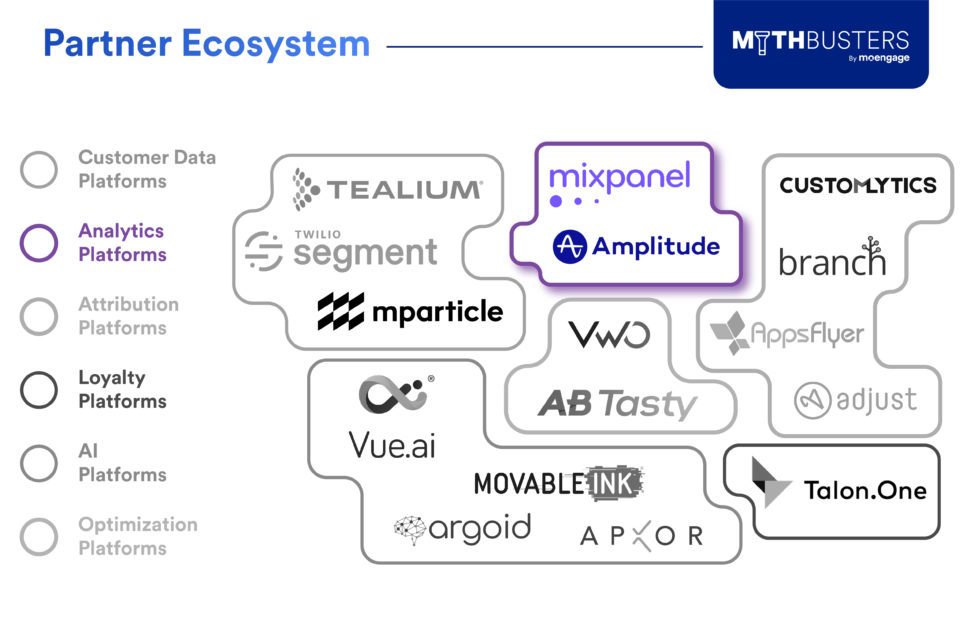
Data helps consumer brands innovate faster. When you analyze how and why your customers engage, convert, and retain in real-time, across devices, you can work toward improving their experience with your brand.
By connecting your existing Analytics platform with MoEngage, you can:
- Set up promotion, engagement, or retention campaigns for customer cohorts identified on your Analytics platform
- Use MoEngage Sherpa to determine the best time/day/week to send campaigns to each individual
- Send communication on each customer’s preferred communication channel (Push Notifications, Email, SMS, In-app Interstitials, Whatsapp, and more)
- Identify your champion customers, most loyal customers, customers about to go dormant, customers most likely to churn, or customers with a high probability to initiate a transaction
- Optimize onboarding, increase n-day retention, and improve engagement efforts through MoEngage Flows
1. Mixpanel
Consumer brands can leverage the Mixpanel <> MoEngage integration to learn insights about customer behavior and translate them into delightful moments by creating customer journeys with hyper-personalized touchpoints across multiple communication channels.
👉 Read more about the Mixpanel and MoEngage integration here.
2. Amplitude
The Amplitude <> MoEngage partnership helps consumer brands boost customer retention and increase conversions by using customer behavior to identify the right cohorts to drive in-product engagement. Additionally, this integration also allows you to measure the impact of campaigns on long-term retention, engagement, product stickiness, and customer LTV.
👉 Check out all the different use-cases of the Amplitude and MoEngage integration here.
MoEngage + Attribution Platforms
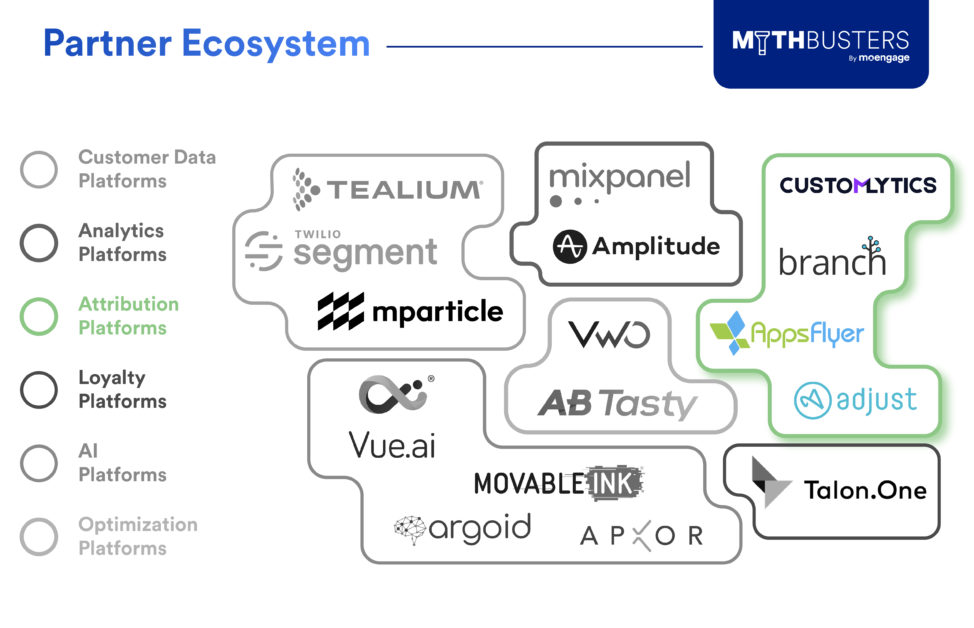
Attribution has always been a topic leading to endless debates and discussions. The way conversions are attributed has a drastic impact on the decisions you make – whether it is allocation of budget or bandwidth, the need to change business goals, or evaluating the performance of a campaign.
Understanding the value of each communication channel and touchpoint during your customer’s journey helps you improve your business metrics and optimize your Customer Engagement efforts.
By setting up the integration with your Attribution platform and MoEngage, you can:
- Analyze the performance of acquisition sources on engagement, retention, and revenue metrics (for example, which Facebook ad campaign led to the highest LTV, or which Snapchat ad campaign resulted in higher customer activity)
- Build relevant onboarding journeys for different customer cohorts depending on their source of acquisition
- Deliver contextual messages that are personalized based on the acquisition channel
- Measure campaign results in real-time and their long-term impact on key business metrics
1. Branch
By integrating Branch with MoEngage you can enable deep-linking on all communication channels (for example, if you send an email promoting the latest DiCaprio movie, you can lead your customers directly to this movie listing on your app or website, instead of redirecting them to your home screen and expecting them to search or browse). This reduces friction in customer experience.
You can also use this integration to map retention, customer LTV, and loyalty to acquisition sources. This helps you better understand your customers and their omnichannel journeys.
2. AppsFlyer
The AppsFlyer <> MoEngage integration helps you identify customers who clicked on a particular banner ad and then proceeded to download your mobile app. You can further get insights on how this customer cohort interacts with the rest of your campaigns, how often they engage with your mobile app, how much they’ve spent, and predict if they are going to churn.
You can then leverage these insights to determine which acquisition channel to double down on or which channel to reduce your efforts on.
3. Adjust
By connecting Adjust and MoEngage, your product and marketing teams can work together through a bidirectional integration and get source-level attribution, deep-link campaigns, deliver personalized messages, and measure campaign results in real-time.
This partnership allows you to import install-attribution data and gather deeper insights into the top-performing sources of your app installs or in-app events.
MoEngage + Optimization Platforms
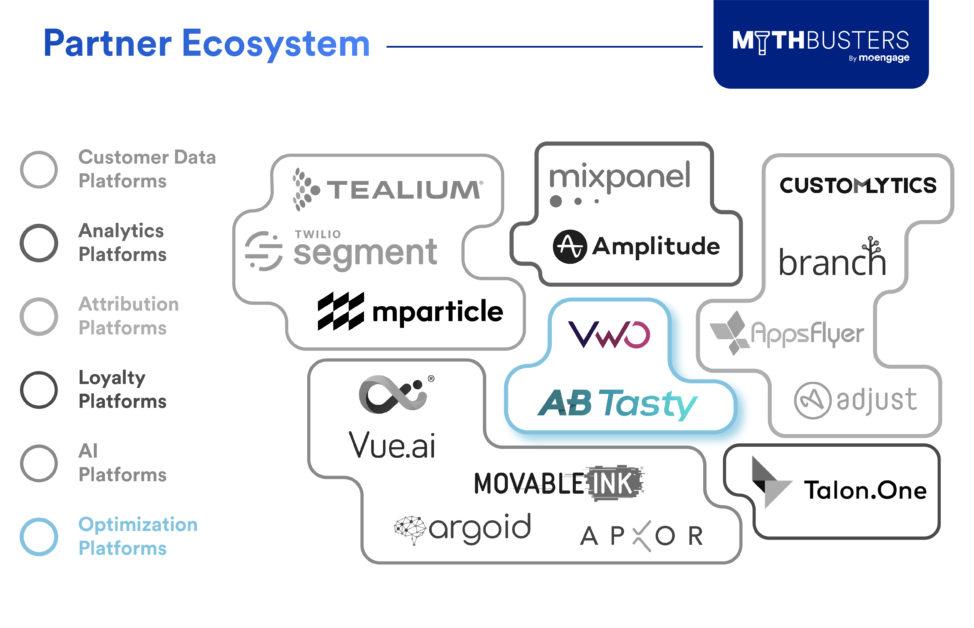
Optimizing customer experience allows you to significantly improve metrics such as click-through rates, conversion rates, customer LTV, loyalty, retention, and more. A/B testing also lets you gather valuable insights about your customers, such as their preferences, interests, and their likes and dislikes. Since Customer Engagement has a lot of moving parts, constant testing and experimentation will always give you an edge above your competitors.
By integrating your Optimization platform with MoEngage you can:
- Identify a specific control group, based on their behavior on your platform, and run experiments on product experience
- Build a customer cohort based on Recency, Frequency, and Monetary scores to test and roll out product features in a phased manner
- Test hypotheses by introducing new customers from particular acquisition sources (such as Facebook ads) to different onboarding experiences
- Implement hyper-personalization by identifying interests, affinities, and preferences of customer cohorts and show them specific webpage colors, homepage banners, and CTA colors and text
- Orchestrate different customer journeys and experiences, leading to the same moment of delight on your platform, for different customer segments based on their geographical location
1. AB Tasty
MoEngage’s AI-driven advanced segmentation and prediction prowess coupled with AB Tasty’s testing and optimization capabilities allow consumer brands to improve conversions at every stage in their customer journey and create relevant experiences across mobile apps and websites.
2. VWO
The VWO <> MoEngage integration helps consumer brands build a customer profile by gathering insights on behavior, preferences, affinity, interests, and attributes. You can then use these insights to create and optimize digital micro-moments by running experiments and testing hypotheses using data.
MoEngage + AI Platforms
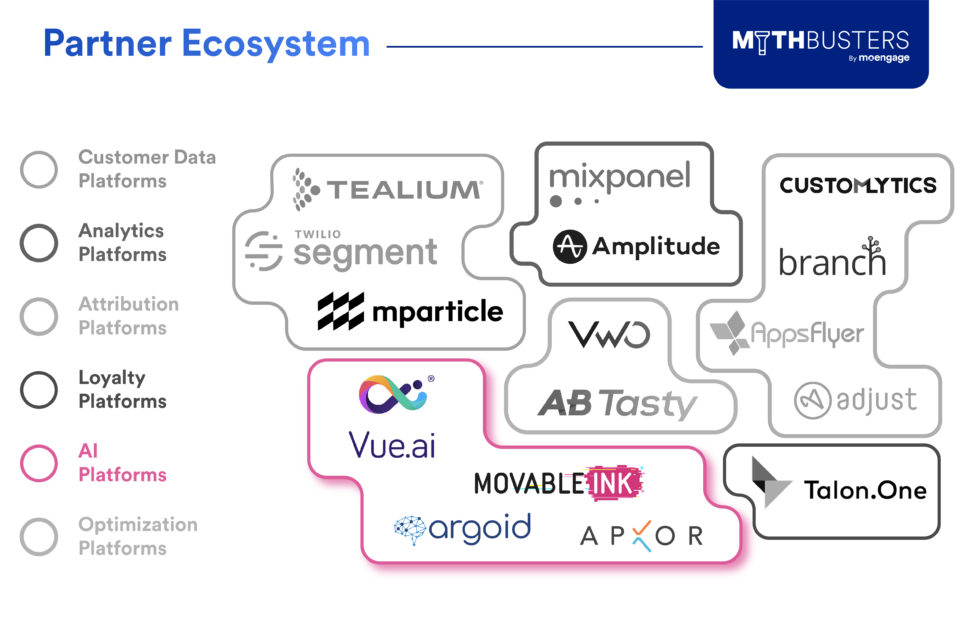
Data-driven consumer brands that use AI and machine learning have the capability to go beyond audience demographics and gather the most important insight – customer intent.
Artificial Intelligence can be used to keep a check on each customer’s experience on your platform and predict what engagement they need to move to the next stage in the funnel. As more data is collected and parsed through, the process becomes more and more fine-tuned, allowing consumer brands to create more effective campaigns and strategies.
By connecting your AI platform with MoEngage you can:
- Create personalized onboarding journeys for new customers by bucketing them into different segments
- Move customers down the funnel by building relevant nudges and reducing customer drop-off in the funnel
- Identify customers who are about to churn and create hyper-personalized experiences on your platform to retain them
- Leverage cross-sell and up-sell opportunities with the right offers and recommendations
1. Apxor
By connecting Apxor with MoEngage, you can use communication channels such as Push Notifications, Emails, or SMSes to bring existing customers back to your platform, and guide them through the optimal conversion path in their journey via nudges, tutorials, and more. You can also measure campaign data to optimize your onboarding, adoption, and activation efforts.
👉 Read how you can benefit from MoEngage’s integration with Apxor here.
2. Vue.ai
The Vue.ai <> MoEngage partnership lets you enable hyper-personalization at scale across mobile, email, web, and SMS touchpoints. You can use this interpretation to send the right product or content recommendation at the right time and on the right channel. You can also analyze how customers react to your campaigns, and delight them with relevant communication at every touchpoint across their lifecycle.
3. Argoid
By integrating Argoid with MoEngage you can boost revenue by improving conversion rates and reducing cart or content abandonment rates. This integration lets you provide 1:1 recommendations to customers in near real-time. You can also leverage this integration to predict customer behavior and set up onboarding, engagement, or retention campaigns accordingly.
4. Pique.ai
The Pique <> MoEngage partnership allows you to deliver contextual emails to the right customers at the right time. You can add product or content recommendations based on a customer’s past behavior (such as searches, clicks, cart events, or email engagement) and not just on their browsing history.
👉 Check out more details about the Pique integration here.
MoEngage + Loyalty Platforms
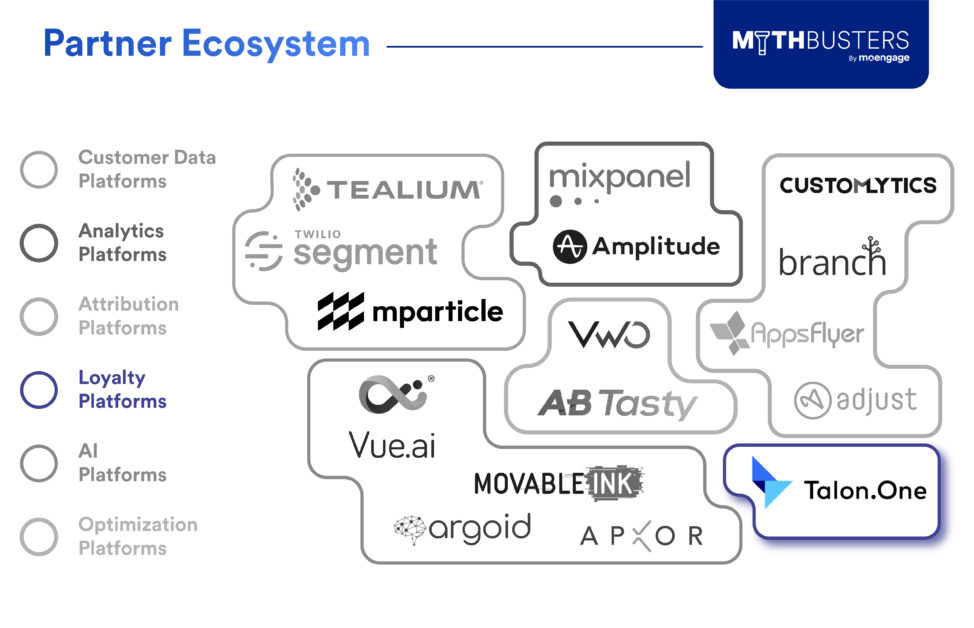
Customer loyalty programs are self-sustaining growth engines that improve customer retention and LTV over time. Loyalty is a powerful emotion. So much so, that customers are ready to overlook the price tag on products or services by the brands they love. Moreover, a well-curated loyalty program leads to a predictable bottom-line for your brand revenue.
By setting up a connection between your Loyalty platform and MoEngage you can:
- Increase customer LTV by building incentive and loyalty programs
- Identify the right customer cohorts for cross-selling and upselling
- Improve Customer Engagement efforts and drive repeat purchases
- Predict which customers are about to churn and send promotions to retain them
Talon.One
With the Talon.One <> MoEngage integration, you can deliver personalized and relevant promotions to the right customers to retain them or increase their LTV. This partnership will let you incentivize your campaigns with rewards and loyalty programs.
Conclusion
The ‘Integrated versus Point solution’ debate is not new for consumer brands. Multiple Point solutions are not better than one Integrated platform for your Customer Engagement needs.
An integrated platform has multiple benefits over multiple point solutions – a 360-degree view of customers on a single platform, simpler training and coordination, a simplified approach to cross-channel reporting and analysis, low maintenance cost, and the convenience and ability to innovate and adapt quickly, to name a few.
By deploying multiple point solutions for your Customer Engagement needs, you end up creating data silos. This approach to engagement is not customer-centric.
An important indication of a single solution for all Customer Engagement challenges is versatility – the existence of a rich partner ecosystem. Ideal Customer Engagement platforms like MoEngage should be able to seamlessly integrate with Analytics, Attribution, Optimization, AI, Loyalty, and Customer Data Platforms.
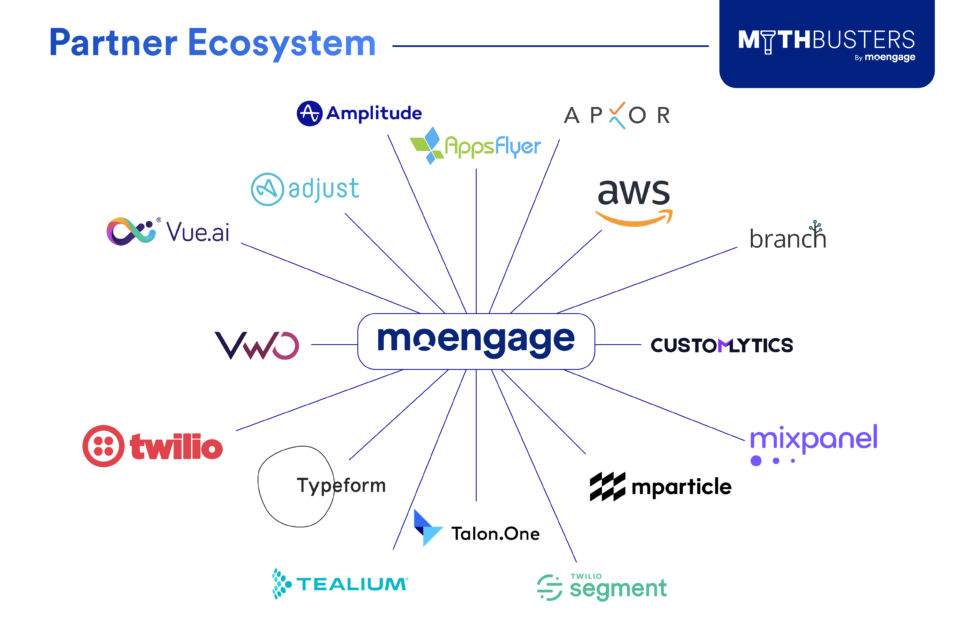
You can explore MoEngage’s partner ecosystem in detail here.














